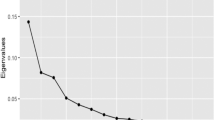Abstract
We show that the single-index dynamic factor model developed by Aruoba and Diebold (Am Econ Rev, 100:20–24, 2010) to construct an index of the US business cycle conditions is also very useful to forecast US GDP growth in real time. In addition, we adapt the model to include survey data and financial indicators. We find that our extension is unequivocally the preferred alternative to compute backcasts. In nowcasting and forecasting, our model is able to forecast growth as well as AD and better than several baseline alternatives. Finally, we show that our extension could also be used to infer the US business cycles very precisely.




Similar content being viewed by others
Notes
AD is based on Aruoba et al. (2009). Their latest version adds a weekly indicator, which implies that the model is computationally demanding to handle the high-frequency indicator. Since we performed thousands of pseudo real-time forecasts, we focus on AD which only uses monthly and quarterly indicators.
It is noteworthy that AD used the Harvey aggregator. In our application, we checked that the empirical differences between these two aggregation methods are negligible.
To facilitate the analysis, following Giannone et al. (2008) financial data are entered into the model as monthly averages since the bulk of information compiled from the indicators is monthly.
We assume that \(\vartheta _{t} \,{\sim }\, N\left( {0,\sigma _{\vartheta }^{2}} \right) \) for convenience but replacements by constants would also be valid.
To simplify the analysis, all the dynamic factor models use \(p1=p2=p3=2.\)
Using larger values of \(h\) does not alter the results.
This result does not imply that the term spread is not a leading economic indicator. This implies that its leading information could be contained already in the rest of the economic indicators included in the model.
Camacho et al. (2012) show that although the fully Markov-switching dynamic factor model is generally preferred to the shortcut of computing inferences from the common factor obtained from a linear factor model, its marginal gains rapidly diminish as the quality of the indicators used in the analysis increases. This is precisely our case.
According to Camacho and Perez Quiros (2007), we included no lags in the Markov-switching specification. We checked that the resulting model is dynamically complete in the sense that the errors are white noise.
References
Aruoba B, Diebold F, Scotti Ch (2009) Real-time measurement of business conditions. J Bus Econ Stat 27:417–427
Aruoba B, Diebold F (2010) Real-time macroeconomic monitoring: real activity, inflation, and interactions. Am Econ Rev Pap Proc 100:20–24
Boivin J, Ng S (2006) Are more data always better for factor analysis? J Econom 132:169–194
Camacho M, Domenech R (2012) MICA-BBVA: a factor model of economic and financial indicators for short-term GDP forecasting. SERIES J Span Econ Assoc 3:475–497
Camacho M, Perez Quiros G (2007) Jump-and-rest effect of U.S. business cycles. Stud Nonlinear Dyn Econom 11(4): article 3
Camacho M, Perez Quiros G (2010) Introducing the Euro-STING: short term INdicator of euro area growth. J Appl Econ 25:663–694
Camacho M, Perez Quiros G, Poncela P (2012) Extracting nonlinear signals from several economic indicators. CEPR Working Paper No. 8865
Diebold F, Mariano R (1995) Comparing predictive accuracy. J Bus Econ Stat 13:253–263
Giannone D, Reichlin L, Small D (2008) Nowcasting: the real-time informational content of macroeconomic data. J Monet Econ 55:665–676
Hamilton J (1989) A new approach to the economic analysis of nonstationary time series and the business cycles. Econometrica 57:357–384
Mariano R, Murasawa Y (2003) A new coincident index of business cycles based on monthly and quarterly series. J Appl Econ 18:427–443
Stark T, Croushore D (2002) Forecasting with real-time data set for macroeconomists. J Macroecon 24:507–531
Stock J, Watson M (1991) A probability model of the coincident economic indicators. In: Lahiri K, Moore G (eds) Leading economic indicators, new approaches and forecasting records. Cambridge University Press, Cambridge
Wheelock D, Wohar M (2009) Can the term spread predict output growth and recessions? A survey of the literature. Fed Reserve Bank St. Louis Rev 91:419–440
Acknowledgments
We would like to thank R. Domenech, N. Karp, H. Danis, the editor, and two anonymous referees for their helpful comments. M. Camacho would like to thank CICYT (ECO2010-19830) for their financial support. All the remaining errors are our own responsibility.
Author information
Authors and Affiliations
Corresponding author
Appendix
Appendix
Without loss of generalization, we assume that our model contains only GDP, one non-financial monthly indicator, and one financial monthly indicator, which are collected in the vector \(Y_{t} =\left( {y_{t}^{*} ,Z_{it}^{*},Z_{ft}^{*}} \right) ^{{\prime }}\). For simplicity’s sake, we also assume that \(p1 = p2 = p3 = 1\), and that the lead for the financial indicator is \(h\) = 1. In this case, the observation equation, \(Y_{t}=Z\alpha _{t}\), is
It is noteworthy that the model assumes contemporaneous correlation between non-financial indicators and the state of the economy, whereas for financial variables, the correlation is imposed between current values of the indicators and future values of the common factor.
The transition equation, \(\alpha _{t} =T\alpha _{t-1} +\eta _{t}\), is
where \(\eta _t \,{\sim }\, iN \left( {0,Q} \right) \) and \(Q={\textit{diag}}\left( {\sigma _{e}^{2} ,0, \ldots ,0,\sigma _{y}^{2} ,0 , \ldots , 0,\sigma _{i}^{2} ,\sigma _{f}^{2}} \right) \).
Rights and permissions
About this article
Cite this article
Camacho, M., Martinez-Martin, J. Real-time forecasting US GDP from small-scale factor models. Empir Econ 47, 347–364 (2014). https://doi.org/10.1007/s00181-013-0731-4
Received:
Accepted:
Published:
Issue Date:
DOI: https://doi.org/10.1007/s00181-013-0731-4



